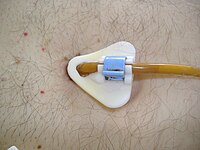
Photo from wikipedia
Abstract Background and objectives A transversus abdominis plane block is a peripheral block method that has been used successfully for pain relief after total abdominal hysterectomy. However, the effects of… Click to show full abstract
Abstract Background and objectives A transversus abdominis plane block is a peripheral block method that has been used successfully for pain relief after total abdominal hysterectomy. However, the effects of the combination of the transversus abdominis plane block and general anesthesia on analgesic and anesthetic requirements remain unclear. This randomized placebo-controlled study is aimed to evaluate the effects of transversus abdominis plane block on analgesic and anesthetic consumption during total abdominal hysterectomy under general anesthesia. Methods Sixty-six women undergoing total abdominal hysterectomy were randomized into two groups to receive general anesthesia alone (control group) or with transversus abdominis plane block using 20 mL of 0.25% bupivacaine (transversus abdominis plane group). Intraoperative remifentanil and sevoflurane consumption were recorded. We also evaluated the postoperative pain, nausea, quality of recovery scores and rescue analgesic requirement during postoperative 24 hours. Results The total remifentanil and sevoflurane consumption is significantly lower in transversus abdominis plane group; respectively mean (SD) 0.130 (0.25) vs. 0.094 (0.02) mcg.kg−1.min−1; p Conclusion Combining transversus abdominis plane block with general anesthesia can provide reduced opioid and anesthetic consumption and can improve postoperative pain and quality of recovery scores in patients undergoing total abdominal hysterectomy.
Journal Title: Revista Brasileira De Anestesiologia
Year Published: 2018
Link to full text (if available)
Share on Social Media: Sign Up to like & get
recommendations!